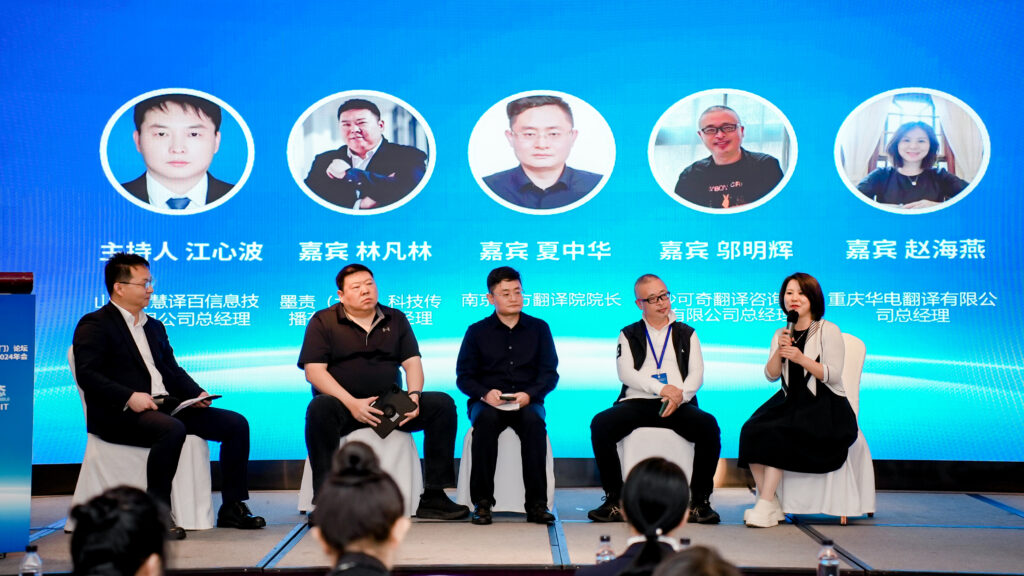Josef Kubovsky(CEO, Nimdzi Insights)就2024语言服务创新发展国际(厦门)论坛的会议内容,撰写了三篇聚焦中国语言服务行业的文章,本文是第三篇。

Collaboration in China’s Language Service Industry: Building Resilience Through Partnership
During my recent visit to TAC LSC 2024 in Xiamen, one of the themes that stood out to me was the emphasis on collaboration in China’s language service industry. Having spent years in the industry, I’ve consistently observed that when LSPs work together – whether on translations, technology development, or even serving the same client – the results are often far greater than what could be achieved individually.
在我最近赴厦参加的TAC LSC 2024会议期间,一个突出的主题是中国语言服务行业对协作的重视。在多年的行业经验中,我始终观察到,无论是在翻译、技术开发还是共同服务客户的过程中,当语言服务提供商(LSP)携手合作时,取得的成果往往超越单独行动的效果。
What struck me in China was how this collaborative spirit is evolving to meet new challenges. At TAC LSC 2024, translation companies – ranging from large enterprises to specialized firms – showcased their ability to pool resources, share expertise, and tackle common problems collectively. In this article, I’ll explore the role of collaboration in China’s language service industry and why it’s more critical than ever for fostering resilience and innovation.
在中国,令我最为印象深刻的是,为了应对新的挑战,这种协作精神正不断演变。在此次会议上,从大型企业到专业化公司,各类翻译公司展示了他们如何共同整合资源、共享专业知识,并集体解决共同问题。在本文中,我将探讨协作在中国语言服务行业中的作用,以及为何它对促进韧性和创新至关重要。
The language service industry faces growing pressures:
语言服务行业正面临日益严峻的压力:
• Pricing Challenges 价格挑战
Global competition and the rise of automated tools are driving down rates.
全球竞争和自动化工具的兴起正在压低收费标准。
• Technological Advancements 技术进步
Companies must embrace tools like generative AI while ensuring they don’t compromise quality.
企业需要拥抱生成式人工智能等工具,同时确保质量不受影响。
• Diverse Client Needs 客户需求多样化
Globalization requires expertise in niche markets and specialized domains.
全球化要求在利基市场和专业领域中具备专长。
At TAC LSC 2024, Haiyan Zhao, a well-known figure in the Chinese language services sector, emphasized that addressing these challenges requires companies to move beyond competition. Instead, they need to seek partnerships that leverage shared resources and expertise.
在此次会议上,中国语言服务行业知名人士赵海燕指出,应对这些挑战需要企业跳出竞争关系,并通过共享资源和专业知识来建立合作关系。
For example, Haiyan highlighted a collaborative effort by several mid-sized LSPs in China who worked together to develop a centralized repository of bilingual corpora for Al training. This approach not only reduced costs for each participant but also improved the quality of machine translations for specialized industries like legal and medical.
例如,赵海燕提到,中国几家中型LSP合作开发了一个用于AI训练的双语语料库集中存储库。这种方法不仅降低了合作公司的成本,还提升了法律和医学等专业领域的机器翻译质量。
• Pooling Resources for Greater Efficiency 资源共享以提高效率
One of the most immediate benefits of collaboration is the ability to share resources. At TAC LSC 2024, a group of translation companies discussed their joint project to create a specialized corpus for patent translations. By combining their linguistic data, they developed a more comprehensive dataset that significantly improved the accuracy of AI-generated translations in this domain.
合作最直接的好处之一是能够共享资源。在会议上,几家翻译公司分享了他们合作创建专利翻译语料库的项目。通过整合语言数据,他们开发了一个更全面的数据集,大幅提高了人工智能生成翻译在该领域的准确性。
• Co-Developing Technology 共同开发技术
China’s LSPs are increasingly partnering with technology providers to create tools tailored to their needs. A standout case presented during the conference was a collaboration between a regional LSP and a local AI company to design a translation management system specifically for Chinese-to-European language workflows. This system automated complex processes like terminology management and client-specific style guides, reducing project turnaround times by 25%.
中国的LSP愈发频繁地与技术公司开展合作,开发满足自身需求的工具。会议上,一个突出案例是由地区性LSP与本地AI公司合作设计的翻译管理系统。该系统专为中文到欧洲语言的工作流设计,自动化处理了术语管理和客户特定风格指南等复杂流程,将项目交付时间缩短了25%。
• Serving Shared Clients 共同服务客户
Collaboration isn’t limited to technology – it can also extend to client service. Several speakers shared examples of LSPs working together to serve multinational clients. For instance, a global electronics brand relied on two Chinese LSPs to handle different aspects of its localization needs: one focused on marketing materials, while the other specialized in technical documentation. By coordinating their efforts, the two companies ensured consistency across all localized content while meeting tight deadlines.
协作不仅仅限于技术开发,还延伸至客户服务领域。几位演讲者分享了LSP为服务跨国客户而展开合作的案例。例如,一家全球电子产品品牌委托两家中国LSP分别负责其本地化需求的不同部分:一家专注于市场营销材料,另一家专攻技术文档。通过协调合作,这两家公司既确保了所有本地化内容的一致性,又在紧迫的交付期限内完成了工作。
Collaboration in China’s language service industry also reflects cultural values of collectivism and shared purpose. During a panel on “Partnerships for a Sustainable Language Industry,” several speakers emphasized how these values influence business practices in the sector.
中国语言服务行业的协作也体现了集体主义和共同目标的文化价值观。在一场题为“可持续语言行业的合作伙伴关系”的圆桌论坛中,多位发言者强调了这些文化价值观是如何影响行业中的商业实践。
One compelling example was shared by Lin Hao, who heads a boutique translation firm in Shanghai. Lin’s company partnered with larger firms to gain access to advanced Al tools, while offering niche expertise in pharmaceutical translations in return. This mutually beneficial relationship not only boosted Lin’s business but also allowed the larger firms to expand their service offerings without overextending their teams.
上海一家专业翻译公司的负责人分享了一个令人信服的案例。他所在的公司通过与更大的企业合作,在获取先进的 AI 工具的同时,以其在医药翻译领域的专业知识作为回报。这种互惠互利的关系不仅促进了其业务的增长,还使大企业能够在不扩张团队的情况下拓展服务范围。
• Accelerating Innovation 加速创新
Collaborative efforts, like the development of bilingual corpora or tailored AI solutions, allow LSPs to innovate faster and more cost-effectively than they could alone.
通过合作开发双语语料库或定制 AI 解决方案等协作努力,LSP可以比单独行动更快、更经济高效地实现创新。
• Building Trust and Quality 建立信任,提升质量
By working together, companies can ensure greater consistency in translations, particularly for clients with large, multifaceted projects.
通过协作,企业可以确保翻译的一致性,尤其是对具有大规模、复杂需求的客户项目。
• Expanding Capabilities 扩展能力
Partnerships enable LSPs to take on projects outside their core expertise, broadening their market reach and increasing client satisfaction.
协作使得LSP能够承接其核心专长之外的项目,拓宽市场覆盖范围,提高客户满意度。
While collaboration offers immense potential, there are challenges that must be addressed:
尽管协作可以激发出巨大的潜力,但也存在需要解决的挑战:
• Data Privacy 数据隐私
Sharing resources requires clear agreements to protect proprietary information.
资源共享需要明确的协议以保护专有信息。
• Alignment Issues 目标一致性
Successful partnerships require aligned goals, transparent communication, and mutual trust.
成功的合作伙伴关系需要一致的目标、透明的沟通和相互信任。
• Balancing Competition 平衡竞争
Some companies hesitate to collaborate with competitors, fearing a loss of market share.
一些公司因担心失去市场份额而不愿与竞争对手合作。
During TAC LSC 2024, several panels, including “Collaboration Models in the Digital Era,” explored practical strategies for overcoming these barriers. Suggestions included creating neutral resource-sharing platforms and developing industry-wide guidelines for ethical collaboration.
在会议期间,包括“数字时代的合作模式”在内的多个专题讨论探讨了克服这些障碍的实用策略。例如,建立中立的资源共享平台和制定行业范围内的道德合作指南。
Reflecting on my time at TAC LSC 2024, I’m inspired by how China’s language service industry embraces collaboration as a strategic advantage. From shared datasets to co-developed tools, these partnerships are fostering innovation and helping companies navigate a rapidly changing landscape.
回顾我在TAC LSC 2024的所见所闻,中国语言服务行业将协作视为战略优势让我深受启发。从共享数据集到共同开发工具,这些合作正在推动创新,帮助企业应对快速变化的环境。
To build on this momentum, LSPs – whether in China or abroad-should consider the following:
为了延续这一势头,无论是中国抑或是其他国家的LSP都可以考虑以下几点:
• Identify Complementary Strengths 发现互补优势
l Seek partners whose expertise complements your own, creating a win-win dynamic.
寻找能与自身专业互补的合作伙伴,创造双赢局面。
• Invest in Shared Platforms 投资共享平台
Develop tools and resources that enable secure, efficient collaboration.
开发支持安全高效协作的工具和资源。
• Foster a Culture of Trust 培养信任文化
Collaboration thrives when companies prioritize mutual benefit over short-term gains.
将长期互惠利益置于短期收益之上。